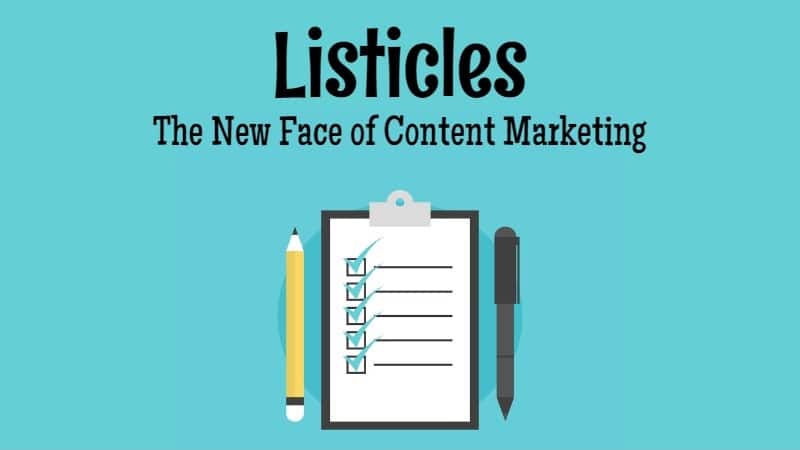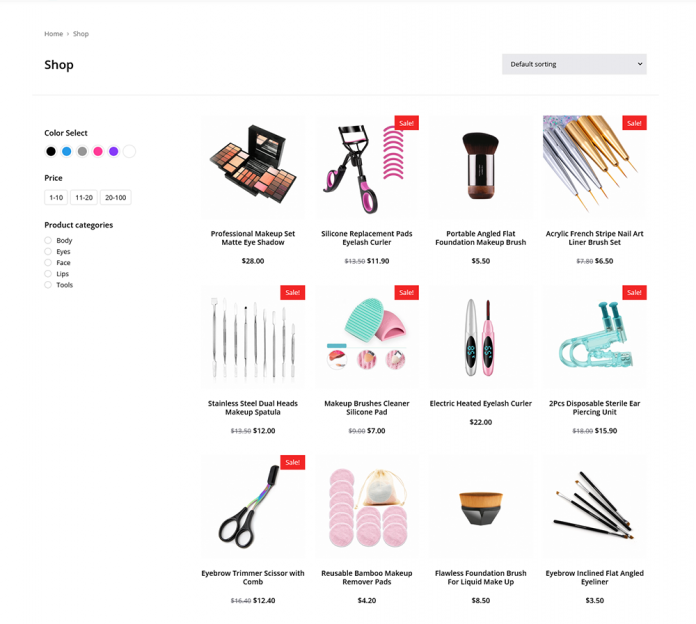Browse any online journal or company blog these days, and you’re bound to come across a listicle.
But what is it about these list-style entries that makes them so popular? And why should you think about incorporating them into your own website or blog?
We’ll answer these questions and go over all you’ll need to know to develop and build your own top-tier listicles in this post.
First, a brief definition.
What exactly is a Listicle?
A listicle, also known as a list-style article, is simply an item that is organized in a list format. A listicle, unlike a standard article, will often include an introduction, a series of numbered entries, and a conclusion.
Why are list posts so powerful?
List articles are a popular format for online content because of the numerous advantages they bring to both consumers and content authors.
Simple to Understand
A listicle simplifies readers’ lives by dividing material into self-contained buckets of information that they can focus on one at a time. Processing material broken into tiny parts is significantly less taxing than tackling a massive wall of text (especially when dealing with multi-layered topics).
Simple to Scan
People desire the ability to zero in on the information they need as rapidly as possible in a world of tight schedules and constant distractions. The listicle style meets this demand by being very easy to skim and by allowing you to move straight to the content that interests you the most.
You Understand What You’re Getting
List postings easily lend themselves to particular, number-oriented names, such as “14 Unique Office Secret Santa Ideas.” Instead of making readers read the piece before deciding if it’s worth their time, article titles like this offer them a clear expectation of what they’ll discover.
A Natural Sense of Progression
Listicles keep us interested in part because they focus on the psychological joy we get from accomplishing small tasks. It’s similar to crossing something off your to-do list: reading one listicle article feels a little pleasant and motivates you to move on to the next.
Simple to Make
Listicles are easier to write than other types of written material such as case studies, white papers, and ultimate guide pieces. Because listicles cover a greater range of subtopics than other pieces, the research necessary is typically lighter. Furthermore, because each article in a listicle can stand on its own two feet, there’s less of a need to meticulously tie different sections of the post together.
None of this is to argue that writing a listicle doesn’t take time and effort. Thorough research, a logical framework, and effective writing are required for every high-quality content. But more on that in a moment.
Simple to Update
Another advantage that listicles have over other sorts of articles is that they are incredibly simple to update. If you wish to add or remove entries from a list post, simply navigate to the relevant area, make the edit, and leave the other entries alone. Simply edit the number in your listicle headline to reflect any changes.
Making a Plan for Your Listicle
Now that you’re convinced of the numerous advantages of listicles, let’s look at how you may make your own.
It should come as no surprise that if you want to construct a well-crafted, value-packed, and traffic-driving listicle, you’ll need to lay some groundwork beforehand.
With that in mind, make sure you complete the following steps before putting pen to paper.
Determine the Article Topic
Picking a topic that lends itself nicely to the listicle style is the first step in generating a list post. Building a listicle around a topic that would be better served as a regular post will only result in a terrible reading experience and, as a result, low search engine rankings.
So, what are the finest topics for listicles?
While there is no official list (excuse the pun) of things you should and should not cover in a list post, you should aim to limit it to topics that may be divided into a number of sub-topics.
Listicle material should include tips, tricks, secrets, statistics, quotes, examples, and anything else that is bite-sized. Topics needing a deep dive or including a substantial narrative aspect, on the other hand, are better suited to a more traditional article approach.
Looking up your topic in Google and seeing if the top-ranking entries are likewise written in list style is an easy method to evaluate if it will work as a listicle. If they aren’t, you should probably avoid making a list post about that subject.
When it comes to selecting a specific topic, make sure it’s in line with your brand and has a strong probability of amusing, educating, or inspiring your target audience.
Have trouble coming up with solid topic ideas? In that situation, it may be worth investigating the kind of publications and social media accounts that are popular with your target readers and noting any issues that jump out. You can also get ideas from search engine data, which brings us to our next point.
Select a Target Keyword
To optimize your content for search engines, you’ll need to choose a target keyword that people are actually searching for. If you skip this stage, it will be considerably more difficult to acquire readers through Google.
Fortunately, choosing a relevant keyword isn’t too difficult. While there are numerous free and paid keyword research tools available (including Google Term Planner, Ahrefs, and SEMrush), one of the most effective ways to find a decent keyword is to just use Google Search.
When you start typing in the search bar, Google will automatically offer a number of additional relevant search terms.
You can also scroll to the bottom of the results page to find more relevant terms.
Focusing on long-tail keywords will increase your chances of ranking highly for your goal keyword. These are less competitive than generic keywords and reflect individual user requests. When you target a long-tail term, you may generate fine-tuned content that caters directly to the user’s search intent, enhancing your ability to rank for that phrase.
Know more about: Social Media SEO, Disavow Links, DealDash, Binance Coin
Select Your Listicle Type
Once you’ve decided on your topic and target keyword(s), the following step is to choose what type of listicle will best fit your needs.
The best listicle structure for you will depend on your topic and how much time you have to devote to research and writing.
Again, the rules for listicle formatting are not set in stone, but here are some common approaches:
- Standard list: This is the most basic sort of listicle, consisting of a succession of brief entries with graphics. The order of entries may be random, however, they are frequently sorted alphabetically, chronologically, or by importance.
- Expanded list: This is the beefed-up brother of the standard list, with each entry expanded to offer more thorough information about the topic at hand. Instead of a phrase or two, these lists will typically contain one or more paragraphs for each item.
- Definitive list: These lists compile the most important information that readers should know about a specific topic. Popular variations include “best-of” and “can’t-miss” lists. Definitive postings are a wonderful method to establish yourself as an authority on your chosen subject.
- Experience-based list: These listicles are intended to pass on lessons learned during the writer’s personal experience with a particular issue.
- Roundup lists: These lists collect statistics or opinions from numerous authorities and specialists in your niche. If done appropriately, they can provide an incentive for anybody featured in the piece to link to it and share it with their followers.
Examine the Competition
The next step is to assess the current top-ranking posts for your desired keyword.
Analyzing the competition will provide you with a clear notion of what material you should include and the minimal level of quality you should provide in your own post. After all, Google ranks its top results based on its best guess of what consumers want to view. So, if all of the top list posts on your chosen topic have 16+ items, odds are a 7-item post will fall short.
Evaluating the competition may also identify unexplored chances to give value to your audience. Checking for reader input in their comment sections is a straightforward method to find relevant subtopics that the competitors may have neglected.
So the goal of researching your competitors’ content is to determine what you should include in your post and to discover new ways to provide even more value. Make certain that you do not plagiarize their content and that you do not provide distinct facts only for the sake of including them.
Create a Distinctive Angle
Picking a new, fascinating approach for your listicle is one of the best methods to separate out from the crowd and deliver more value to readers.
Of course, this is easier said than done, but one strategy is to consider your competition’s views and consider how you could better them with an unexpected twist.
Assume your goal phrase is “tips for touring Europe,” and the top three Google results are all versions of “X advice for traveling across Europe.” You may differentiate your message by using a more unconventional approach, such as “X recommendations for exploring Europe (that will keep you out of trouble).”
Other fantastic methods to provide value include drawing on your own experiences, soliciting feedback from other influencers in your industry, and, of course, reporting any primary data that you’ve collected yourself.
Don’t just regurgitate what’s already out there, whatever you do. If your listicle provides nothing unique in comparison to items that already rank high for your topic, your prospects of garnering viewers and backlinks are slim.
Outline Each Item in the List
The final stage in creating your listicle is to outline each item and conduct any necessary research. Having a clear skeleton in place ahead of time will make writing the piece much easier.
If you need to arrange your list entries in a specific order, now is the time to do so.
You don’t have to be concerned with the precise amount of items on your list (as long as it’s not significantly more or less than the competition’s). What matters most is that you supply high-quality content for each item you have.
The level of detail you give for each item will vary depending on the type of listicle you’re creating. A standard list may suffice with surface-level information, however, an expanded list will undoubtedly require more content. Again, you may utilize the competition to determine how much detail is required.
Keep in mind that viewers will be looking for the greatest content accessible on your topic. So, before you begin writing, make sure you have the most up-to-date information and gather any data, quotes, graphics, or screenshots that you believe will assist bring your piece to life.
How to write a Listicle?
Now that you’ve completed your topic research and article format, it’s time to begin writing your list article.
Make An Interesting Introduction
A strong start to your listicle is critical because 55 percent of readers will only stay for 15 seconds or less.
Your introduction has two purposes: it piques the reader’s curiosity and sets the tone for the body of your content. It should also include your primary keyword.
So make sure your introductory words get right to the point and make it crystal clear to the reader what value they will derive from it.
Include Body Content in Each List Point
The following step is to fill out your list of items utilizing the information gathered during the planning phase.
Your readers will not tolerate fluff, just as they will not tolerate fluff in your introduction, so make sure that every sentence offers value. Also, if you make any strong, factual claims, make sure to back them up with references. If you believe it will benefit your visitors, incorporate contextual connections to other posts on your site as well as authoritative third-party content.
Your best chance for writing style is to make it moderately conversational and to favor clarity above all else. If you’re writing for a lay readership, avoid using jargon and make sure to define any technical phrases you employ.
Finally, to boost your ranking potential, include your goal term throughout your body content. However, do not fill your post with awkwardly placed keywords, since this can turn off readers and may harm your SEO efforts.
Context can be added by using images and video
Images, graphics, and videos will not only break up the boredom of nonstop reading; they will also provide readers with the context they need to really understand what you’re saying.
According to a study, we recall about 10% of a piece of information three days after reading it, but up to 65% if the information is accompanied by a picture.
If you are unable to create your own photographs, you can always obtain free, high-quality images on websites such as Flickr and Unsplash. Just make sure you follow all attribution guidelines.
Include a Strong Conclusion
When it comes to producing blog posts, many content authors treat the conclusion as an afterthought.
This is a blunder.
With a clear call to action, your conclusion should restate the main lessons from your listicle and provide some final reason for your readers to take action. You may, for example, encourage them to put what they’ve learned into practice, share the post with their friends and colleagues, join up for your email list, or look at another piece of material on your site.
Listicle Posting Best Practices
Now that we’ve covered the core processes in creating a great list article, let’s take a brief look at some important best practices to remember before you click publish.
Take Care of the Formatting
We’ve already seen that one of the main benefits of listicles is that they’re quick to scan and read.
However, this is only true if you format them appropriately!
Make the sub-headings for each of your list items stand out by formatting them as H2 headers (or H3 headers nestled within a sub-heading), and don’t forget to number them so readers know where they are.
You should use line breaks to separate your paragraphs and keep them to three or four sentences. When you need to highlight critical information, utilize bullet lists, bold fonts, and italics.
For particularly large lists, consider including a table of contents with jump links at the beginning of the post or in the sidebar. Your viewers will be able to quickly navigate to the area of the post that most interests them.
Avoid titles that are clickbait!
To the degree that listicles have a poor name in the content marketing field, it’s because too many writers have used misleading headlines to entice readers to click on their articles.
Your headline must correspond to what you discuss in your listicle. While the goal of a headline is to catch the reader’s attention, you should avoid employing sensationalist or unduly controversial titles.
Don’t Mislead Your Readers
Similarly, avoid annoying your readers by removing any vague or extraneous information, factual inconsistencies, or obvious spelling and grammatical problems.
Before publishing, double-check and edit your content, and keep the end aim in mind: to write a high-quality post that your audience will want to read.
Conclusions on List-Style Articles
For good reason, list postings have become an immensely popular way to display content. They are a far more comfortable way for users to consume information, and they are simpler to create than traditional articles.
Regardless, compiling a top-tier listicle is no easy task. To attract a large readership and compete in search engine results pages, you must first properly prepare, research, create, and format your list post.
The good news is that this essay has covered all of the key actions you’ll need to take to succeed with listicles. So now it’s up to you to go out there and teach the rest of the world how it’s done!
You May also like sitescorechecker, Pro Site Ranker








